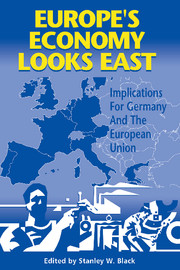Book contents
- Frontmatter
- Contents
- List of figures and tables
- Preface
- List of conference participants
- List of acronyms
- 1 Introduction
- I Trade relations
- II Investment patterns
- 5 Investment and its financing during the transition in Central and Eastern Europe
- Comments
- 6 Privatization, structural change, and productivity; toward convergence in Europe?
- Comments
- III Labor market issues
- IV The process of integration
- Index
5 - Investment and its financing during the transition in Central and Eastern Europe
Published online by Cambridge University Press: 03 February 2010
- Frontmatter
- Contents
- List of figures and tables
- Preface
- List of conference participants
- List of acronyms
- 1 Introduction
- I Trade relations
- II Investment patterns
- 5 Investment and its financing during the transition in Central and Eastern Europe
- Comments
- 6 Privatization, structural change, and productivity; toward convergence in Europe?
- Comments
- III Labor market issues
- IV The process of integration
- Index
Summary
Introduction
The end of the Cold War found the countries that spent the previous 45 years under Communism recovering from a legacy of misguided economic incentives and policies and a system built on false premises. The 75 percent gap in income levels between the Central and Eastern European Countries (CEECs) and the members of the European Union (EU) is a major barrier preventing the CEECs' entry into the EU, a key political goal. This gap not only raises the cost of including the CEECs in the EU's income redistribution programs such as the Common Agricultural Policy and the Regional and Structural Funds, it also forms the basis for low wage competition for the “sensitive” industries in the EU, which already face severe competition from Third World countries.
This paper addresses some of the issues involved in closing the income gap, assessing the growth potential and associated investment demand in Bulgaria, the Czech Republic, Hungary, Poland, Slovakia, and Romania, collectively called the CEECs. Over the past five years, a variety of estimates have been made of the demand for investment in these transition economies. The most popular approach relies on a production function to estimate the starting level of capital stock required to produce the starting level of output, assuming a given degree of inefficiency in the initial use of capital and labor (Boote, 1992; Giustiniani, Papadia and Porciani, 1992; Holzmann, Thimann and Petz, 1994). Catching up to Western European levels of output depends on the elimination of these inefficiencies and the accumulation of capital.
- Type
- Chapter
- Information
- Europe's Economy Looks EastImplications for Germany and the European Union, pp. 167 - 200Publisher: Cambridge University PressPrint publication year: 1997
- 2
- Cited by



